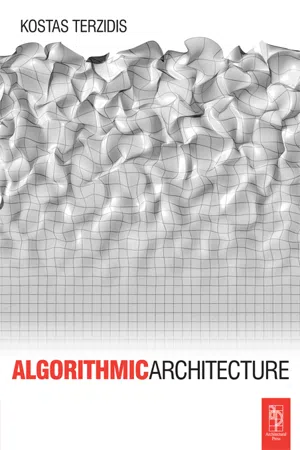Recursive Algorithm
A recursive algorithm is a problem-solving approach where a function calls itself to solve smaller instances of the same problem. This technique is commonly used in computer science to solve problems that can be broken down into smaller, similar sub-problems. Recursive algorithms often involve a base case to stop the recursion and prevent infinite loops.
3 Key excerpts on "Recursive Algorithm"
- eBook - ePub
- Kostas Terzidis(Author)
- 2006(Publication Date)
- Routledge(Publisher)
...4 Scripts, algorithms, and other predicaments An algorithm is a computational procedure for addressing a problem in a finite number of steps. It involves deduction, induction, abstraction, generalization, and structured logic. It is the systematic extraction of logical principles and the development of a generic solution plan. Algorithmic strategies utilize the search for repetitive patterns, universal principles, interchangeable modules, and inductive links. The intellectual power of an algorithm lies in its ability to infer new knowledge and to extend certain limits of the human intellect. An algorithm may be compared to the steps in a recipe; the steps of gathering the ingredients, preparing them, combining them, cooking, and serving are algorithmic steps in the preparation of food. Obviously, the number, size, and quality of ingredients, the sequence and timing of events, as well as the serving and presentation of the final product are key factors to a recipe. Theoretically, an algorithm is the abstraction of a process and serves as a sequential pattern that leads towards the accomplishment of a desired task. For instance, the algorithm for cooking potatoes may be composed of the following steps: 1. Peel 2. Boil 3. Cut 4. Serve If the steps are reversed or one more step is added or deleted, alternative recipes may be created that produce different results. These results may be better, the same, or worse than the original intention. However, as in cooking, alterations, randomness, or accidents in the process may lead to new solutions, none of which was known in advance and whose newly emerged identity often differs significantly from the originally intended target...
- eBook - ePub
The Cyber Patient
Navigating Virtual Informatics
- Rebecca Mendoza Saltiel Busch(Author)
- 2019(Publication Date)
- Productivity Press(Publisher)
...Chapter 6 Algorithms Effective algorithms make assumptions, show a bias toward a simple solution, trade off the costs of error against the cost of delay, and take chances. Brian Christian American nonfiction, science, and philosophy author Tom Griffiths Professor of Psychology and Cognitive Science at UC Berkeley and Director, Computational Cognitive Science Lab Introduction An algorithm is a constructed set of specifically defined procedures that act upon stored or input data in a specified sequence. An algorithm answers a specific question in response to a hypothesis or to generate intelligence to create a hypothesis for further analysis. The key is to ask the right question that will have a measurable impact on day-to-day health decisions. This chapter provides a fundamental overview of algorithms. These concepts have been applied among all technology platforms. Understanding Algorithms Algorithms can execute a process or build models for predictive behavioral analysis. An algorithm could be an informal set of processes or a formal, specifically defined process. Formal processes are required for algorithms managed via the use of a computer programming language that tells the computer what to do. One simple algorithm written for an insurance company’s claims adjudication system requires that, for every claim submitted, a patient be a member of the company’s insurance program. If the patient is not part of that program, then the algorithm directs the insurance company to deny the claim. An informal algorithm can be expressed using everyday language. Language coupled with the structure of grammar and use of known references can create a prescribed set of procedures. Consider the following narrative: At approximately 8 a.m. the students will arrive at school to register for the final examination. The test will begin at 9 a.m. Late arrivals will not be allowed into the examination room. The relationships in the narrative are straightforward...
- eBook - ePub
- James Bird, Helen Caldwell, Peter Mayne(Authors)
- 2017(Publication Date)
- Learning Matters(Publisher)
...This can be achieved without the need for ‘expert’ knowledge and even in many cases without the need to use a computer! The New Collins Concise English Dictionary (2011) defines algorithms as any method or procedure of computation, usually a series of steps. Computational thinking should be seen as a problem-solving process, which incorporates the use of algorithms by analysing and logically organising data. Lesson idea: introducing algorithms This lesson focus is on algorithms being a sequence of precise instructions and related to the need for digital devices also to have precise instructions, in order to follow a preset program with a predetermined outcome. Before you start Be clear in your own mind what an algorithm is and how the concept can be embedded in a cross-curricular way. Pupils need to be grouped according to ability. Things you need • Toaster, bread, knife and margarine for the teacher demonstration. • Laminated cards – on each card should be one of the steps for cleaning teeth (the sequence has been decomposed into smaller steps), Blu-tack, mini-whiteboards. Context After an initial teacher demonstration, this particular lesson plan focuses on creating an algorithm for cleaning teeth, which would link well to personal, social, health and economic education, and with a topic on ‘All About Me’. The principle of this lesson could also be used in many different contexts, for example, crossing a road, making a sandwich, getting dressed. Learning objectives • To understand the term ‘algorithm’. • To understand the precise nature of algorithms. • To understand that algorithms provide the precise instructions for common digital devices. Lesson outline In order for pupils to understand the term ‘algorithm’, they need to create some of their own and try them out in the physical sense...


